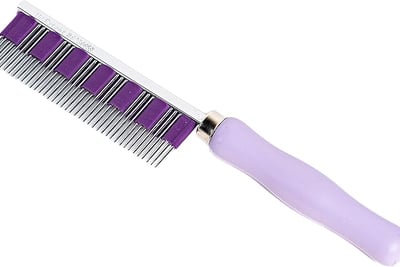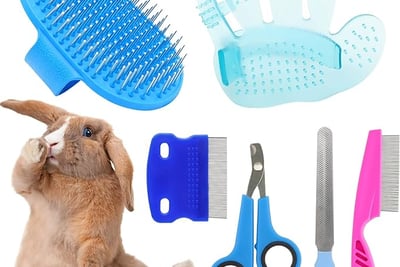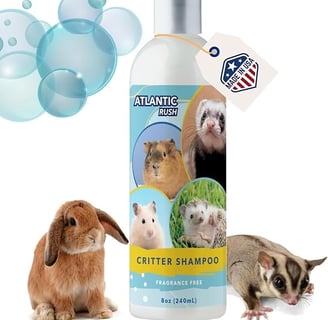The Ultimate Guide to Grooming Your Rabbit: Tools and Techniques Explained
8 min read


Understanding the Importance of Rabbit Grooming
Grooming is a fundamental aspect of rabbit care that should not be overlooked. Maintaining a regular grooming routine is essential for the overall health and well-being of your rabbit. One of the primary reasons grooming is crucial is that it aids in the prevention of matting. Rabbits have a dense fur coat that can easily become tangled, leading to discomfort and skin irritations if not managed properly. By regularly brushing your rabbit, you can help keep their coat free of tangles and mats, ensuring they remain comfortable and healthy.
Additionally, grooming plays a vital role in reducing shedding. Rabbits naturally shed their fur, particularly during seasonal changes. However, excessive shedding can lead to hairballs, which pose potential health risks. By engaging in regular grooming sessions, you can effectively manage shedding, minimizing the chances of hairballs and promoting a cleaner living environment. This practice is especially beneficial during shedding seasons, helping to keep your home fur-free and preventing hair from accumulating in various areas.
Beyond the physical benefits, grooming also fosters emotional bonding between you and your rabbit. Regular grooming sessions can create an opportunity for interaction, allowing you to strengthen your relationship with your pet. This bonding experience can be particularly soothing for rabbits, helping to alleviate stress and anxiety. Many rabbits enjoy the sensation of being brushed, and the comfort derived from regular grooming sessions can lead to a calmer, more relaxed disposition.
Ultimately, understanding the importance of grooming your rabbit can significantly impact their quality of life. From maintaining their physical health to promoting emotional well-being, the practice of grooming is an essential component of responsible rabbit ownership. Engaging in this routine not only benefits your pet, but also allows you to cultivate a deeper connection with your furry companion.
When to Groom Your Rabbit
Grooming your rabbit is an essential aspect of responsible pet ownership, as it contributes significantly to their overall health and well-being. Understanding when to groom your rabbit is contingent on various factors, including breed, fur type, and seasonal changes. Every rabbit has unique grooming needs that must be tailored accordingly.
Different breeds exhibit varying fur types that dictate their grooming frequency. For example, long-haired breeds such as Angoras and Holland Lops require more frequent grooming, usually at least two to three times a week, to prevent matting and tangling. In contrast, short-haired breeds, like Rex rabbits, may only need grooming once a week. It's essential to consider your rabbit's specific breed when determining an appropriate grooming schedule.
Seasonality plays a pivotal role in grooming frequency as well. Rabbits typically experience heavier shedding in the spring and fall, often referred to as "blowing coat" periods. During these times, rabbits shed clumps of fur to adapt to changing temperatures. To manage this increased fur loss, it is advisable to increase grooming sessions to help remove loose hair and mitigate matting. Daily grooming during shedding seasons can be beneficial, as it not only aids in fur management but also strengthens the bond between you and your rabbit.
It's crucial to differentiate between regular grooming and occasional grooming. Regular grooming involves routine maintenance that helps prevent health issues related to skin and coat. Occasional grooming, on the other hand, might be necessary during times of increased shedding or after a health event that may impact the rabbit's ability to groom itself adequately. Adapting your grooming strategy based on these factors will result in a more comfortable experience for your rabbit and promote optimal fur health.
Essential Grooming Tools for Rabbits
Grooming your rabbit is an essential aspect of maintaining their health and well-being. Having the right tools can make this process more effective and enjoyable for both you and your pet. Below is a list of grooming tools that are necessary for effective rabbit grooming, taking into account the various types of rabbit fur.
One of the most important tools is a quality brush. For rabbits with long fur, a slicker brush is recommended as it effectively removes tangles and mats while distributing natural oils throughout the coat. For shorter-furred rabbits, a bristle brush can work well, aiding in the removal of loose fur and dirt. It's crucial to ensure that the brush is gentle to avoid irritating your rabbit’s sensitive skin.
Another useful tool is a comb, particularly a wide-toothed comb for long-haired breeds. This is effective for detangling without pulling on the fur excessively. A fine-toothed comb can also help in the grooming process by catching smaller mats or debris that the brush might miss. Always opt for metal or sturdy plastic combs to ensure durability.
Nail clippers are also a significant component of grooming. There are specific rabbit nail clippers, which are generally smaller and designed to control the delicate clipping. Alternatively, a human nail clipper can work if it is used cautiously. Regular nail trimming is important, as overgrown nails can lead to discomfort and health issues for your rabbit.
Lastly, a grooming glove can be an innovative addition. These gloves have rubber bristles and allow you to groom your rabbit while petting them, which can be comforting. This tool can effectively collect loose fur and pet dander, making it easier to keep your living space clean.
Utilizing these essential grooming tools will help maintain your rabbit’s coat and hygiene, contributing to their overall health and happiness.
Preparing Your Rabbit for Grooming
Grooming is a significant part of rabbit care that requires thorough preparation for both the rabbit and the groomer. Establishing a safe and comfortable environment is crucial to ensure the grooming session proceeds smoothly. Start by selecting a quiet, well-lit area free from distractions and potential hazards. Utilize a non-slippery surface, such as a grooming mat, to facilitate a secure grooming experience. This approach not only protects the rabbit but also aids in preventing mishaps during the process.
Many rabbits experience anxiety, particularly when introduced to grooming activities. To help calm a nervous rabbit, it is beneficial to spend a little time interacting with the pet beforehand. Petting your rabbit gently and speaking in a soothing voice can help ease its stress levels. Creating an atmosphere of trust will make the grooming session feel less intimidating. Offer treats or favorite toys to encourage positive associations with grooming, allowing your rabbit to associate this experience with comfort rather than fear.
When holding your rabbit during grooming, it’s important to position it correctly to ensure safety and security. Use both hands to support the rabbit's body: one hand should cradle the chest while the other supports the rear. This method not only helps to prevent the rabbit from jumping or wriggling free, but it also provides them with a sense of stability. Maintaining a gentle grip is essential, as excessive pressure can create additional fear and resistance. Furthermore, regularly observing your rabbit's body language will aid in identifying signs of discomfort or unease, informing you when it may be necessary to take a break or adjust your approach.
By establishing a suitable environment, alleviating anxiety, and securely holding your rabbit, you set a strong foundation for successful grooming sessions. These preparatory steps are essential to ensuring that both the groomer and the rabbit have a productive and pleasant experience.
Step-by-Step Grooming Process
Grooming your rabbit is essential for its overall health and well-being. A systematic approach not only helps keep your rabbit’s coat clean but also strengthens the bond between you and your pet. Here is a detailed step-by-step guide on how to groom a rabbit effectively.
Begin with brushing your rabbit’s fur, which helps prevent mats and reduces shedding. Different fur types require specific grooming tools; for short-haired rabbits, a rubber brush can be effective, while long-haired rabbits may benefit from a comb or slicker brush. Start at the neck and work towards the tail, using gentle strokes to remove loose hair without damaging the coat. Pay close attention to the undercarriage and behind the ears, as these areas often collect debris.
Next, it is crucial to clean the ears and eyes of your rabbit. For the ears, utilize a cotton ball lightly dampened with a rabbit-safe solution to wipe the inner ear gently. This prevents ear infections. As for the eyes, check for any discharge or tearing; if necessary, use a soft, damp cloth to clean around the eyes, ensuring you do not apply pressure directly on the eye itself.
Following these steps, you should trim your rabbit's nails to avoid overgrowth. Using a pair of rabbit-safe nail clippers, carefully cut the tip of the nail, avoiding the quick, which is the pink section that contains nerves and blood vessels. For the best results, hold the rabbit securely and consider having a second person assist in gently restraining your pet during this process.
Lastly, always be vigilant and check for any skin issues during grooming, such as lumps, bumps, or signs of moisture. These can indicate health problems that may require veterinary care. Regular grooming provides an excellent opportunity to not only maintain your rabbit's cleanliness but also monitor its health and behavior, fostering a comfortable and happy pet environment.
Common Grooming Issues and How to Address Them
Rabbits, like any other pets, require regular grooming to maintain their health and appearance. However, owners may encounter various grooming challenges as they care for their furry companions. Understanding these common issues will help in addressing them effectively. One frequent problem is tangles and matting in the fur, especially for long-haired breeds. Regardless of the rabbit’s hair type, it can become knotted due to dirt, shedding, or irregular grooming. To alleviate tangles, it is advisable to use a wide-toothed comb or a slicker brush designed specifically for rabbits. Designating a grooming schedule can also help prevent matting from becoming a significant issue.
Another common concern among rabbit owners is excessive shedding. Since rabbits undergo seasonal changes, they may shed more in spring and autumn. This shedding can lead to fur being ingested, which could result in gastrointestinal problems. To mitigate this risk, owners should frequently brush their rabbits, using a gentle approach to remove dead hair while minimizing stress for the animal. High-quality hay and a balanced diet rich in fiber can further aid in promoting healthy shedding and minimizing fur ingestion.
Skin irritations, such as dandruff or hot spots, may also occur and can be signs of underlying issues, including parasites or allergies. If a rabbit exhibits unusual scratching or has visible lesions, it is crucial to evaluate their environment and grooming products for irritants. Regular checks and routine grooming can help identify these symptoms early on. If irritations persist or worsen, consulting a veterinarian for proper diagnosis and treatment is essential. Recognizing these common grooming issues and implementing strategies to address them can significantly enhance your rabbit's well-being and overall grooming experience.
Maintaining a Regular Grooming Schedule
Establishing a consistent grooming schedule for your rabbit is crucial for their health and well-being. Regular grooming not only helps in managing their coat but also allows you to monitor your rabbit's overall condition, including their skin, eyes, and nails. By adhering to a grooming calendar, you can ensure that your rabbit receives the care they need at appropriate intervals. This schedule can be customized based on the breed, age, and health of your rabbit, considering factors such as shedding cycles and fur length.
To create an effective grooming calendar, begin by assessing your rabbit’s grooming needs. For long-haired breeds, such as Angoras, daily grooming may be required to prevent matting, while short-haired breeds might need grooming once a week. Incorporate these grooming sessions into your daily or weekly routine, treating them as essential activities. You can use digital reminders on your phone or create a physical calendar where you can mark off completed sessions. This not only keeps you accountable but also allows you to note any changes in your rabbit’s fur or skin condition over time.
Additionally, making grooming a positive experience is essential for fostering a trusting relationship between you and your rabbit. Begin each session with gentle handling and provide positive reinforcement, such as treats or gentle strokes. This helps your rabbit associate grooming with positive experiences. Allow your rabbit to take breaks during grooming sessions, and ensure that the environment is calm and secure. Over time, your rabbit will become accustomed to the process, making it easier for both of you. Maintaining a regular grooming schedule is vital not only for your rabbit’s appearance but for their health, contributing to a happier and healthier companion.











